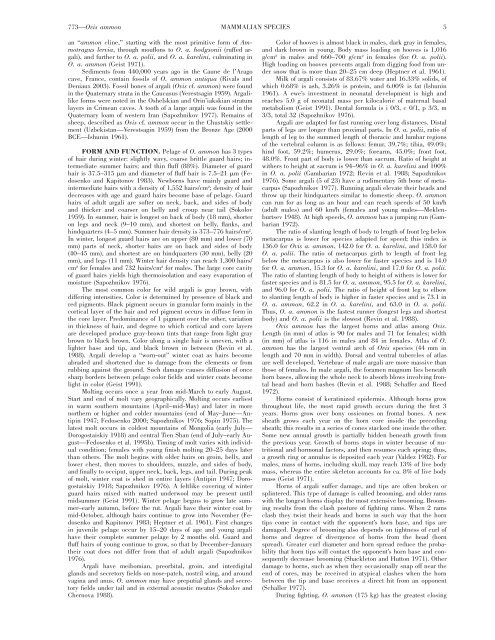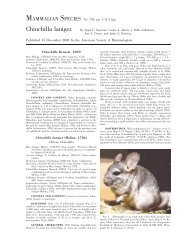Create successful ePaper yourself
Turn your PDF publications into a flip-book with our unique Google optimized e-Paper software.
773—<strong>Ovis</strong> <strong>ammon</strong><br />
MAMMALIAN SPECIES 5<br />
an ‘‘<strong>ammon</strong> cline,’’ starting with the most primitive form of Ammotragus<br />
lervia, through mouflons to O. a. hodgsonii (ruffed argali),<br />
and further to O. a. polii, and O. a. karelini, culminating in<br />
O. a. <strong>ammon</strong> (Geist 1971).<br />
Sediments from 440,000 years ago in the Caune de l’Arago<br />
cave, France, contain fossils of O. <strong>ammon</strong> antiqua (Rivals and<br />
Deniaux 2003). Fossil bones of argali (<strong>Ovis</strong> cf. <strong>ammon</strong>) were found<br />
in the Quaternary strata in the Caucasus (Verestsagin 1959). Argalilike<br />
forms were noted in the Oshelskian and Orin’iakskian stratum<br />
layers in Crimean caves. A tooth of a large argali was found in the<br />
Quaternary loam of western Iran (Sapozhnikov 1977). Remains of<br />
sheep, described as <strong>Ovis</strong> cf. <strong>ammon</strong> occur in the Chustskiy settlement<br />
(Uzbekistan—Verestsagin 1959) from the Bronze Age (2000<br />
BCE—Ishunin 1961).<br />
FORM AND FUNCTION. Pelage of O. <strong>ammon</strong> has 3 types<br />
of hair during winter: slightly wavy, coarse brittle guard hairs; intermediate<br />
summer hairs; and thin fluff (88%). Diameter of guard<br />
hair is 37.5–315 m and diameter of fluff hair is 7.5–21 m (Fedosenko<br />
and Kapitonov 1983). Newborns have mainly guard and<br />
intermediate hairs with a density of 1,552 hairs/cm 2 ; density of hair<br />
decreases with age and guard hairs become base of pelage. Guard<br />
hairs of adult argali are softer on neck, back, and sides of body<br />
and thicker and coarser on belly and croup near tail (Sokolov<br />
1959). In summer, hair is longest on back of body (18 mm), shorter<br />
on legs and neck (9–10 mm), and shortest on belly, flanks, and<br />
hindquarters (4–5 mm). Summer hair density is 373–776 hairs/cm 2 .<br />
In winter, longest guard hairs are on upper (80 mm) and lower (70<br />
mm) parts of neck, shorter hairs are on back and sides of body<br />
(40–45 mm), and shortest are on hindquarters (30 mm), belly (20<br />
mm), and legs (11 mm). Winter hair density can reach 1,300 hairs/<br />
cm 2 for females and 732 hairs/cm 2 for males. The large core cavity<br />
of guard hairs yields high thermoisolation and easy evaporation of<br />
moisture (Sapozhnikov 1976).<br />
The most common color for wild argali is gray brown, with<br />
differing intensities. Color is determined by presence of black and<br />
red pigments. Black pigment occurs in granular form mainly in the<br />
cortical layer of the hair and red pigment occurs in diffuse form in<br />
the core layer. Predominance of 1 pigment over the other, variation<br />
in thickness of hair, and degree to which cortical and core layers<br />
are developed produce gray-brown tints that range from light gray<br />
brown to black brown. Color along a single hair is uneven, with a<br />
lighter base and tip, and black brown in between (Revin et al.<br />
1988). Argali develop a ‘‘worn-out’’ winter coat as hairs become<br />
abraded and shortened due to damage from the elements or from<br />
rubbing against the ground. Such damage causes diffusion of once<br />
sharp borders between pelage color fields and winter coats become<br />
light in color (Geist 1991).<br />
Molting occurs once a year from mid-March to early August.<br />
Start and end of molt vary geographically. Molting occurs earliest<br />
in warm southern mountains (April–mid-May) and later in more<br />
northern or higher and colder mountains (end of May–June—Antipin<br />
1947; Fedosenko 2000; Sapozhnikov 1976; Sopin 1975). The<br />
latest molt occurs in coldest mountains of Mongolia (early July—<br />
Dorogostaiskiy 1918) and central Tien Shan (end of July–early August—Fedosenko<br />
et al. 1995b). Timing of molt varies with individual<br />
condition; females with young finish molting 20–25 days later<br />
than others. The molt begins with older hairs on groin, belly, and<br />
lower chest, then moves to shoulders, muzzle, and sides of body,<br />
and finally to occiput, upper neck, back, legs, and tail. During peak<br />
of molt, winter coat is shed in entire layers (Antipin 1947; Dorogostaiskiy<br />
1918; Sapozhnikov 1976). A feltlike covering of winter<br />
guard hairs mixed with matted underwool may be present until<br />
midsummer (Geist 1991). Winter pelage begins to grow late summer–early<br />
autumn, before the rut. Argali have their winter coat by<br />
mid-October, although hairs continue to grow into November (Fedosenko<br />
and Kapitonov 1983; Heptner et al. 1961). First changes<br />
in juvenile pelage occur by 15–20 days of age and young argali<br />
have their complete summer pelage by 2 months old. Guard and<br />
fluff hairs of young continue to grow, so that by December–January<br />
their coat does not differ from that of adult argali (Sapozhnikov<br />
1976).<br />
Argali have meibomian, preorbital, groin, and interdigital<br />
glands and secretory fields on nose-patch, nostril wing, and around<br />
vagina and anus. O. <strong>ammon</strong> may have preputial glands and secretory<br />
fields under tail and in external acoustic meatus (Sokolov and<br />
Chernova 1988).<br />
Color of hooves is almost black in males, dark gray in females,<br />
and dark brown in young. Body mass loading on hooves is 1,016<br />
g/cm 2 in males and 660–700 g/cm 2 in females (for O. a. polii).<br />
High loading on hooves prevents argali from digging food from under<br />
snow that is more than 20–25 cm deep (Heptner et al. 1961).<br />
Milk of argali consists of 83.67% water and 16.33% solids, of<br />
which 0.68% is ash, 3.26% is protein, and 6.00% is fat (Ishunin<br />
1961). A ewe’s investment in neonatal development is high and<br />
reaches 5.0 g of neonatal mass per kilocalorie of maternal basal<br />
metabolism (Geist 1991). Dental formula is i 0/3, c 0/1, p 3/3, m<br />
3/3, total 32 (Sapozhnikov 1976).<br />
Argali are adapted for fast running over long distances. Distal<br />
parts of legs are longer than proximal parts. In O. a. polii, ratio of<br />
length of leg to the summed length of thoracic and lumbar regions<br />
of the vertebral column is as follows: femur, 39.7%; tibia, 49.0%;<br />
hind foot, 59.2%; humerus, 29.0%; forearm, 45.0%; front foot,<br />
48.0%. Front part of body is lower than sacrum. Ratio of height at<br />
withers to height at sacrum is 94–96% in O. a. karelini and 100%<br />
in O. a. polii (Gambarian 1972; Revin et al. 1988; Sapozhnikov<br />
1976). Some argali (5 of 23) have a rudimentary 5th bone of metacarpus<br />
(Sapozhnikov 1977). Running argali elevate their heads and<br />
throw up their hindquarters similar to domestic sheep. O. <strong>ammon</strong><br />
can run for as long as an hour and can reach speeds of 50 km/h<br />
(adult males) and 60 km/h (females and young males—Meklenburtsev<br />
1948). At high speeds, O. <strong>ammon</strong> has a jumping run (Gambarian<br />
1972).<br />
The ratio of slanting length of body to length of front leg below<br />
metacarpus is lower for species adapted for speed; this index is<br />
136.0 for <strong>Ovis</strong> a. <strong>ammon</strong>, 142.0 for O. a. karelini, and 158.0 for<br />
O. a. polii. The ratio of metacarpus girth to length of front leg<br />
below the metacarpus is also lower for faster species and is 14.0<br />
for O. a. <strong>ammon</strong>, 15.3 for O. a. karelini, and 17.0 for O. a. polii.<br />
The ratio of slanting length of body to height of withers is lower for<br />
faster species and is 81.5 for O. a. <strong>ammon</strong>, 95.5 for O. a. karelini,<br />
and 96.0 for O. a. polii. The ratio of height of front leg to elbow<br />
to slanting length of body is higher in faster species and is 73.1 in<br />
O. a. <strong>ammon</strong>, 62.2 in O. a. karelini, and 63.0 in O. a. polii.<br />
Thus, O. a. <strong>ammon</strong> is the fastest runner (longest legs and shortest<br />
body) and O. a. polii is the slowest (Revin et al. 1988).<br />
<strong>Ovis</strong> <strong>ammon</strong> has the largest horns and atlas among <strong>Ovis</strong>.<br />
Length (in mm) of atlas is 90 for males and 71 for females; width<br />
(in mm) of atlas is 116 in males and 84 in females. Atlas of O.<br />
<strong>ammon</strong> has the largest ventral arch of <strong>Ovis</strong> species (44 mm in<br />
length and 70 mm in width). Dorsal and ventral tubercles of atlas<br />
are well developed. Vertebrae of male argali are more massive than<br />
those of females. In male argali, the foramen magnum lies beneath<br />
horn bases, allowing the whole neck to absorb blows involving frontal<br />
head and horn bashes (Revin et al. 1988; Schaffer and Reed<br />
1972).<br />
Horns consist of keratinized epidermis. Although horns grow<br />
throughout life, the most rapid growth occurs during the first 3<br />
years. Horns grow over bony ossicones on frontal bones. A new<br />
sheath grows each year on the horn core inside the preceding<br />
sheath; this results in a series of cones stacked one inside the other.<br />
Some new annual growth is partially hidden beneath growth from<br />
the previous year. Growth of horns stops in winter because of nutritional<br />
and hormonal factors, and then resumes each spring; thus,<br />
a growth ring or annulus is deposited each year (Valdez 1982). For<br />
males, mass of horns, including skull, may reach 13% of live body<br />
mass, whereas the entire skeleton accounts for ca. 8% of live body<br />
mass (Geist 1971).<br />
Horns of argali suffer damage, and tips are often broken or<br />
splintered. This type of damage is called brooming, and older rams<br />
with the longest horns display the most extensive brooming. Brooming<br />
results from the clash posture of fighting rams. When 2 rams<br />
clash they twist their heads and horns in such way that the horn<br />
tips come in contact with the opponent’s horn base, and tips are<br />
damaged. Degree of brooming also depends on tightness of curl of<br />
horns and degree of divergence of horns from the head (horn<br />
spread). Greater curl diameter and horn spread reduce the probability<br />
that horn tips will contact the opponent’s horn base and consequently<br />
decrease brooming (Shackleton and Hutton 1971). Other<br />
damage to horns, such as when they occasionally snap off near the<br />
end of cores, may be received in atypical clashes when the horn<br />
between the tip and base receives a direct hit from an opponent<br />
(Schaller 1977).<br />
During fighting, O. <strong>ammon</strong> (175 kg) has the greatest closing
















